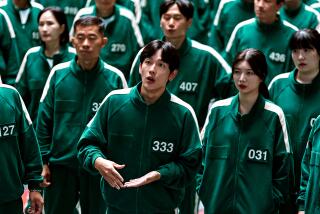Fashion hits the virtual world of video games
- Share via
NEXT month, shoppers will be able to walk into H&M and buy a nautical-inspired minidress designed by 21-year-old Beau Fornillos, who created the sporty frock using a computer video game.
Fornillos isn’t a professional fashion designer. He built the dress on the Sims 2 video game and uploaded it to an online runway, where it was judged by a panel of H&M designers in Stockholm. Coming in first meant having his outfit actually manufactured and sold by the chain store. Sort of like a “Project Runway” challenge in cyberspace.
The dress is bricks-and-mortar evidence of just how pervasive fashion has become in the shoot-’em-up world of gaming. What began as a few product placements in sports games has morphed into a category of its own.
Along with Sims 2, there are a slew of fashion games that allow players to shop, tailor and design -- competitively, of course. The newest of the games is based on Japanese street style. Even Karl Lagerfeld has a cameo in the latest Grand Theft Auto.
Game-makers say style is helping them snare more female gamers, a demographic that hadn’t been specifically targeted by the starships-and-shotguns industry. Today, 55% of Sims 2 players are female.
“The female audience is the next step for video games to grow,” said Jarik Sikat, U.S. sales and marketing manager for KOEI Corp., which will debut Pop Cutie! Street Fashion Simulation for the Nintendo DS in September.
The game, the first to tackle street fashion in the U.S., is based on a Japanese game called “That’s QT.” It’s a homage to the audacious street style of Tokyo and Harajuku -- the costumey Japanese maid and Goth Lolita looks that are popping up more and more. Players start the game as small-time designers with a tiny shop at a flea market. As they excel at running their shop, they move on to bigger boutiques, where they buy and design their own clothes and do battle against other shop owners. This is no Barbie fashion show -- battles are judged on who’s styled the coolest, most out-there Gothic Lolita, emo or glam style ensemble.
“You can create more conventional fashions in the game,” said Sikat, “but the entertainment really gets punched up when you can create a pink cat costume.” A little more this-world, Ubisoft Entertainment recently introduced two fashion games for the DS system. In Fashion Designer, players design clothes, choosing swatches of fabric and sample silhouettes. And in the newer My Fashion Studio, gamers are judged on tailoring time, fashion choices and accuracy as they create their own clothing collection, then customize models for the runway or a photo shoot.
In Sims 2, players can take their avatars shopping at a virtual H&M, plucking looks from the current season that are also available in the stores (dress like your character!), and stage runway shows where they pick the models, clothes and music.
In this virtual fashion show, models strut down the runway wearing cool half-smiles and, say, a floor-length H&M floral maxi dress with a plunging neckline. The avatar’s stride is inhumanly fluid, long arms and legs swishing past each other with Rolex precision. At the end of the catwalk, she thrusts out a single hip, then swirls around and cheekily blows the audience a kiss. The turn could rival Kate Moss or Agyness Deyn for sheer sass.
Fornillos, the winner of last year’s contest, managed to dress his avatar in something that walked straight into the real world.
“Judges were looking for a balance between creative design and commerciality,” says Steve Lubomski, U.S. advertising director for H&M. “We wanted to be certain the garment would fit into our collection and would be something our customers would embrace and want to wear.”
But forget H&M. What about Proenza Schouler? So far, most big-name designers have ignored gaming. The exception (and isn’t he always?) is Lagerfeld, a 74-year-old early adopter who is so tech-happy he has several iPods and a designated assistant to carry them. The Chanel designer appears as a radio DJ in “Grand Theft Auto IV,” Rockstar Games’ latest frenetic car chase game.
Still, the industry is showing signs of developing good taste. Nintendo, which offers the popular DS and Wii platforms, just debuted a style-y metallic rose-colored DS model, which tweens are blinging out with glued-on rhinestones and tassels. And new commercials for the DS feature Nicole Kidman playing Rock, Paper, Scissors, Liv Tyler tapping on virtual piano keys, and America Ferrera engrossed in the New Super Mario Bros.
In tech years, it’s been a long time coming. Fashion’s flirtation with virtual worlds started when gaming was still a boys’ club: ballers in the basketball game NBA 2K6 wore Nikes, Reebok branded on billboards and soccer balls in Pro Evolution Soccer 6 and Tony Hawk is still clad in the latest Quiksilver looks in his Activision skateboarding games.
Then came Second Life in 2003, an online universe where users shopped at big-name stores such as American Apparel, Reebok and Adidas as part of a virtual life they created. Less a game than a trippy pastime, and shopping is one of the major activities.
Fine. But they’re selling T-shirts and sneakers, not Marchessa and Missoni.
And how thrilling would it be to dress in all that expensive stuff and not have to pay for it? There’s a game we might really give up shopping for.






